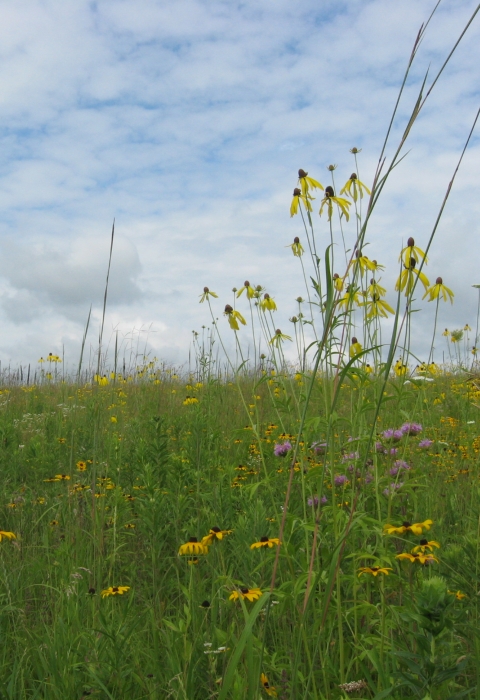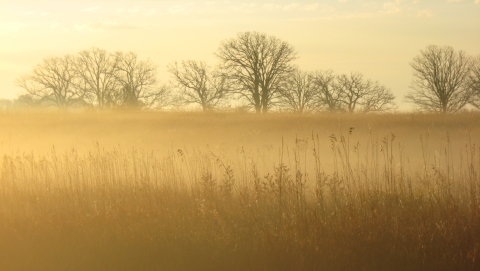About Us
St. Croix Wetland Management District was established in 1992 for the purpose of providing wetland and grassland habitat for breeding waterfowl. The district encompasses eight counties in west-central Wisconsin and is responsible for the management of 8700 acres of public lands on 44 separate tracts of the National Wildlife Refuge System called waterfowl production areas.
The landscape of the St. Croix Wetland Management District transitions south to north from the bluffs of the Mississippi River to prairie pothole wetlands to northern forest. The prairie pothole portion of the district is dotted with thousands of small wetlands, created by glaciers. Prior to European settlement of west-central Wisconsin, in what is now St. Croix, Dunn and Polk counties, American Indians of the Ojibwe, also known as Chippewa, and Sioux peoples found more than 200,000 acres of tallgrass prairie, wetlands and oak savanna from which to hunt, fish and gather. This complex of prairie, wetlands and oak savanna was very productive, both for wildlife and for farming. The area was a paradise for waterfowl, bobolinks, meadowlarks, upland sandpipers and other prairie dependent wildlife.
Oak Ridge Lake, found on Oak Ridge Waterfowl Production Area, is recognized as a Wetland Gem by Wisconsin Waterfowl Association. These areas are considered high quality representations of the critically important habitats that historically made up nearly a quarter of Wisconsin’s landscape.
Our Mission
The mission of St. Croix Wetland Management District is to restore the prairie, wetlands, and oak savanna historically found throughout the eight county district.
The mission of the National Wildlife Refuge System is to administer a national network of lands and waters for the conservation, management and, where appropriate, restoration of the fish, wildlife and plant resources and their habitats within the United States for the benefit of present and future generations of Americans.
Every national wildlife refuge national wildlife refuge
A national wildlife refuge is typically a contiguous area of land and water managed by the U.S. Fish and Wildlife Service for the conservation and, where appropriate, restoration of fish, wildlife and plant resources and their habitats for the benefit of present and future generations of Americans.
Learn more about national wildlife refuge and wetland management district wetland management district
A wetland management district is a U.S. Fish and Wildlife Service office that manages waterfowl production areas in one or more counties. Waterfowl production areas are small natural wetlands and grasslands that provide breeding, resting and nesting habitat for waterfowl, shorebirds, grassland birds and other wildlife. The Fish and Wildlife Service acquires waterfowl production areas under the authority of the Migratory Bird Hunting and Conservation Stamp Act, primarily using funds from the sale of Federal Duck Stamps. The Refuge System’s 38 wetland management districts comprise thousands of waterfowl production areas – almost all in the Prairie Pothole Region of the Northern Great Plains.
Learn more about wetland management district was created for a special purpose. Some were created to protect migratory birds, others to protect threatened or endangered species or unique habitats, while others fulfill other special purposes. All activities allowed on refuges and wetland management districts must be evaluated to make sure each activity is compatible with the purposes for which the refuge or district was established.
St. Croix Wetland Management District was created for the purpose of providing wetland and grassland habitat for breeding waterfowl and other migratory birds.
Our History
1958 - Waterfowl production areas were authorized by an amendment to the Federal Duck Stamp Act. Scientists realized that protection and management of small land parcels of wetland and grassland habitat were vital to maintaining continental populations of breeding waterfowl. This amendment gave the U.S. Fish and Wildlife Service authorization to purchase these small land parcels with wetland habitat. Your purchase of a federal duck stamp provides funds to acquire, oversee and manage waterfowl production areas and easements.
1974 - Agreement signed between Wisconsin Governor Patrick Lucey and Director of the U.S. Fish and Wildlife Service Lynn Greenwalt that authorized U.S. Fish and Wildlife Service to expend proceeds from the Federal Duck Stamp to purchase lands in Wisconsin for purposes of providing wetland and grassland habitat for breeding waterfowl. These small tracts of land were called waterfowl production areas and would be administered by the Wisconsin Department of Natural Resources, as part of the National Wildlife Refuge System.
October 10, 1974 - The first parcel of land as part of the St. Croix Wetland Management District was purchased from Carl and Marjorie Bethke in St. Croix County. The lands purchased from the Bethke’s are now part of Oak Ridge and Oak Ridge South Waterfowl Production Areas.
Summer 1992 - Management of waterfowl production areas reverted back to the U.S. Fish and Wildlife Service from Wisconsin Department of Natural Resources.
July 1, 1993 - St. Croix Wetland Management District was officially established by the U.S. Fish and Wildlife Service and staff that were hired to acquire and manage waterfowl production areas in the eight county area of northwest Wisconsin.
2000 - Formal establishment of the Partners for Fish and Wildlife program on the district. While district staff worked cooperatively with neighbors with adjacent property to the waterfowl production areas, as well as other private landowners as time allowed, the first biologist dedicated to working with private landowners was hired to implement the Partners for Fish and Wildlife program in 2000. This program was formally established in 1987 by U.S. Fish and Wildlife Service and works beyond the boundaries of refuges with landowners and other partners to improve habitat on private lands for fish and wildlife.
Other Facilities in this Complex
Whittlesey Creek National Wildlife Refuge, a 305-acre refuge located in northern Wisconsin on the shore of Lake Superior in Bayfield County, Wisconsin is part of the St. Croix Wetland Management District complex. The project leader for the district is also the refuge manager for Whittlesey Creek National Wildlife Refuge, supervises the single staff person assigned to the refuge that is co-located with other federal and state partners at the David R Obey Northern Great Lakes Visitor Center Ashland, Wisconsin and is also on the Board of Directors for the Center.


